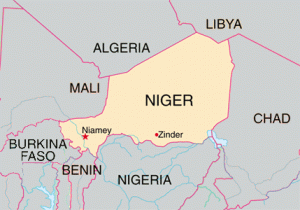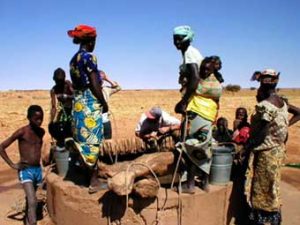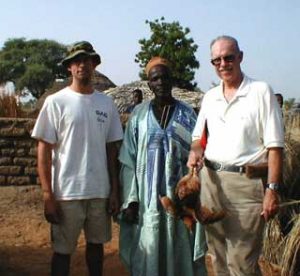by J.R. Bullington
American Diplomacy takes pleasure in providing one of the outlets for this latest of Ambassador Bullington’s “Letters from Niger.” To this venerable editor they bring to mind Janet Flanner’s erudite and perceptive “Letters From Paris” published periodically years ago in The New Yorker. Perhaps this series should be renamed “Letters from Niamey,” but never mind. Read, appreciate, learn!—Ed
 Heat
Heat
Heat is much on our minds these days.
Niger doesn’t have a cold season, but the months of November through February are quite pleasant. It starts getting hot again in March, and April and May are the two hottest months, with daytime highs of 120F or more and nighttime lows in the 90s. The June-September rains cool things off a bit, but at the same time make it more humid and sometimes even more uncomfortable.
For the past few days I’ve been watching the thermometer on our deeply shaded verandah. It’s usually just over 90F when I leave for the office at 7:30, and somewhere around 110F when I return around 4:30. In the daytime sun, I’m sure the temperature gets to the 120F level.
We are most grateful for air conditioning, and at the same time filled with admiration for the fortitude of our Peace Corps Volunteers and the people they serve in villages where air conditioning has not yet even been imagined.
New Volunteers
Of the 54 trainees who arrived in January, one quit, one was medically evacuated, and 52 were sworn in as Volunteers on March 29. They completed 11 weeks of training, focused on learning a local language, understanding Nigerien culture, and mastering the difficult art of living and working in a remote village with no electricity, telephones, running water or indoor toilets, in the midst of grinding poverty, with oppressive heat, and exposed to a host of unusual diseases.

They have now been in their villages for three weeks, and thus far only one has quit and gone home.
This is an “early termination” rate well below the worldwide Peace Corps average. I find this remarkable, since Niger is certainly among the most challenging of Peace Corps assignments. Moreover, of the group of 35 Volunteers who completed their two years of service in early April, 16 decided to stay here for some additional time (ranging from a month to a year), and two more extended their service for a year to join the new Peace Corps program to be launched in East Timor in June. This is an extension rate well above the worldwide Peace Corps average.
And finally, Niger is located in a very tough global neighborhood. Four of the seven states on its borders—Algeria, Libya, Chad and Nigeria—are poster countries for various sorts of terrorism, anti-Americanism, political and religious extremism, and bloody ethnic warfare. And those borders are highly porous.
All Americans should be proud of these young Volunteers, just as we are proud of our men and women in the military. They represent our country at its best.
What Volunteers do
The Volunteers prepare various kinds of reports on their activities. I’ve excerpted four recent ones below, to let them tell you in their own words about some of the things they do.
Brian’s well (dug by hand, in a village near his own)

I began researching the project in January 2001. I networked with friends and organizations back in the US, and by March I had found a parish in Indianapolis that was willing to finance my well. The total cost was $4349. Most of the money was spent on cement, rebar, transportation, and salary for the two well foremen.
The well diggers, young volunteers from the village, struck the water table at meter 48. They dug an additional three meters, which is necessary to ensure that there is at least one meter of standing water throughout the year.
Prior to construction, the closest potable water source for Alfagey Kwara was a three-kilometer walk. I became interested in constructing a well when I found that the villagers were drawing water from a local pond, because it was only a 10-minute walk. That same pond was used by domestic animals and nomads, who bathe, defecate and wash their clothes in it.
Consequently, the villagers suffered from a variety of digestive, feet, dermatological and vision problems due to water-borne diseases.
The construction of the well, completed January 17, provided 500 villagers and nomads a clean, easily accessible and dependable source of water that should last for at least 25 years. Hopefully, the infant mortality rate due to dysentery will be dramatically reduced. Educating villagers on how to keep a more sanitary environment and to plant gardens and fruit trees nearby will further improve the situation.The lack of equipment, infrastructure, good business practice, motivation and foresight that plague Niger made this project extremely labor intensive and time consuming. I began to appreciate the enormity of the workers’ effort when I spent three days and nights at the site. I went there with the intention of speeding up completion of the project. I quickly realized that the casual work ethic of the laborers was only a fraction of the problem. The reality was that the workers were physically drained and scared of the work conditions at the bottom of a 150-foot well.
In addition to the volunteer labor, the villagers provided lodging and meals for the foremen, gravel and sand for cement, and donkey-cart transportation for the materials, as well as $150 in cash.
Maureen’s lessons (from a just-departed Volunteer)
On my arrival in Karmaoua, I easily identified their problems and proposed solutions to them. Early on, I learned the greatest lesson of my service: The solutions I found for people were not necessarily the ones they would choose for themselves.

I saw that the best I could do was to integrate small lessons, especially on health and hygiene, into the daily lives of the villagers. At first it was frustrating to put effort into tasks that seemed only to provide entertainment for the people of my village. Now, after two years of living with them, I see my neighbors doing things I repeated countless times. I never expected that it would require so much stubbornness and persistence, but I have to admit it is quite gratifying to finally see people making saline solution to clean their and their children’s eyes, and to see them improve their low level of health and hygiene without my interference but with the information that I have shared with them.
We held a village meeting, which actually introduced the people of Karmaoua to the alien concept of meetings. In the past, people would only gather together to discuss land disputes. I have been preparing them for the role of the next Volunteer by telling them of the importance of working together as a community. (Maureen was the first Volunteer in this village—we normally have a series of three before moving on to another village.)
I have hopefully introduced insight into a notion of future growth. My belief is that the best a Peace Corps Volunteer can do here is work at the village level to help people improve their lives within a traditional world and culture where, despite their huge hardships, people are relatively content. If any improvement is to really stay, it must be initiated and undertaken by them.
Chad’s thank-you letter (for funding to build a school)

When I first came to Zongo Mozague I never thought the building of a school was possible during my service. Then, when the villagers and I began petitioning the Government for a teacher, I never thought one would come in the first year. When the teacher came, I didn’t realize how fast the children would learn.Just three months after the building of the temporary, millet stalk school, I witnessed a dramatic improvement in abilities. Children that couldn’t hold a pen three months ago are now writing their names and can name all the village animals in French. With the building of a permanent school, these children and those of the future will be guaranteed years of learning. The villagers are so proud, and are extremely thankful for the opportunity their children have been given.
Jocelyn’s job description (to share with prospective Peace Corps recruits in the US)
I live in a small village in southern Niger. I am the only Volunteer in my village, but I have a Volunteer neighbor in another village six kilometers away. There is no school in my village, so very few people speak French. I rely entirely on my local language, Zarma, to communicate.

Volunteers are placed as a member of the community, so our living conditions are very primitive. I sleep outside, have no running water or electricity, and do much of my work by hand. I live in a thatch-roofed mud hut, within my village chief’s yard, somewhat like a guest hut. He and his brother have become my village dads and their wives my village moms. Much of my time is spent with those families, under their shade trees.
Although I am a Natural Resources Management Volunteer, I have an informal background in infant health. As a result I spend a lot of that time under the shade trees to talk to mothers about child nutrition and health. And whenever I am invited to a baptism or other village event, I try to encourage good practices and discourage harmful ones.In terms of conservation, I have worked hard to encourage the preservation of trees. Much of this work is in the form of informal discourse. I also started an environmental education youth group. The goal is to introduce concepts of conservation to village children so they can grow up knowing how precious their forests are.
I have my own millet field and use it to try to demonstrate different farming practices, although first my villagers had to teach me how to farm. I also work closely with the regional Government forestry agent, to help bring his projects to my village.
Reminders of Indochina

When visiting Volunteer villages, I always call on the village chief (usually to be found sitting with other elders under a centrally located shade tree), to thank him for assuring the safety and welfare of our Volunteer. Few of the chiefs speak French, so I usually have to communicate with them through the Volunteer. On a few occasions, however, I have discovered that the chief is a veteran of the French army who fought in Indochina. We are thus able to speak directly, and can reminisce a bit about our experiences and our respective wars.These French army veterans are well respected men, likely to be chosen as village chiefs because of their age (most would be in their 70s or older), their experience of the outside world, and their relative wealth. (They receive a French government pension of about $400 a year, a large sum in a Nigerien village.)
While they came from several colonies, including Niger, most of the French African troops in Indochina were from Senegal. When I was in Vietnam in the 60s, many Vietnamese still used the term “Senegalais” to refer to black American soldiers.
It’s interesting to meet a few of these old veterans and share some distant memories.
Visit to the US
We plan to be in the US for vacation June 15 – July 10. The itinerary is Orange County, north Georgia, Norfolk, and Washington, DC. In addition to visiting family and friends, we’ll be getting some routine medical check-ups and putting Kevin in boarding school at Fork Union Military Academy, near Charlottesville, VA; and I’ll check in with Peace Corps headquarters in Washington.
We look forward to seeing many of you during the trip.
